Trade Liberalization Impact on Gender Inequality in Bangladesh
VerifiedAdded on 2022/11/17
|29
|6945
|305
Report
AI Summary
This report examines the impact of trade liberalization and globalization on gender inequality in Bangladesh, focusing on the period from 1990 to 2017. The study utilizes data from UNDP, WHO, and other sources to analyze trends in education, health, and the labor market. It constructs a Gender Inequality Index (GII) using a modified methodology, considering factors like the school ratio of girls to boys and the ratio of female to male teachers. The analysis includes correlation and regression analyses to determine the relationship between trade liberalization and gender inequality, with detailed calculations and formulas presented in the appendices. The research aims to provide insights into how economic policies and global integration affect gender disparities in Bangladesh, offering valuable information for policymakers and organizations working towards gender equality. The report also explores the theoretical implications of these findings and their practical applications.
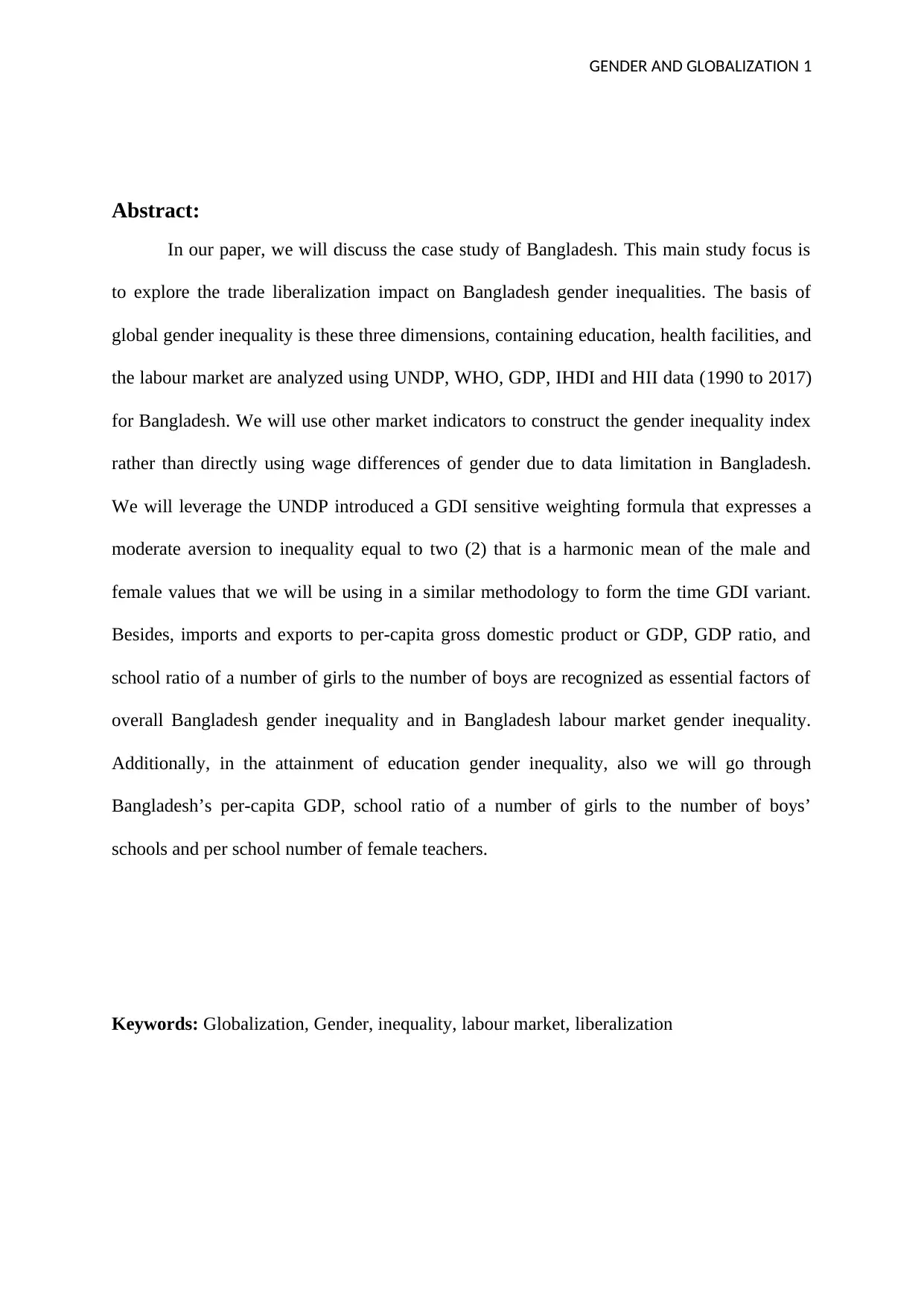
GENDER AND GLOBALIZATION 1
Abstract:
In our paper, we will discuss the case study of Bangladesh. This main study focus is
to explore the trade liberalization impact on Bangladesh gender inequalities. The basis of
global gender inequality is these three dimensions, containing education, health facilities, and
the labour market are analyzed using UNDP, WHO, GDP, IHDI and HII data (1990 to 2017)
for Bangladesh. We will use other market indicators to construct the gender inequality index
rather than directly using wage differences of gender due to data limitation in Bangladesh.
We will leverage the UNDP introduced a GDI sensitive weighting formula that expresses a
moderate aversion to inequality equal to two (2) that is a harmonic mean of the male and
female values that we will be using in a similar methodology to form the time GDI variant.
Besides, imports and exports to per-capita gross domestic product or GDP, GDP ratio, and
school ratio of a number of girls to the number of boys are recognized as essential factors of
overall Bangladesh gender inequality and in Bangladesh labour market gender inequality.
Additionally, in the attainment of education gender inequality, also we will go through
Bangladesh’s per-capita GDP, school ratio of a number of girls to the number of boys’
schools and per school number of female teachers.
Keywords: Globalization, Gender, inequality, labour market, liberalization
Abstract:
In our paper, we will discuss the case study of Bangladesh. This main study focus is
to explore the trade liberalization impact on Bangladesh gender inequalities. The basis of
global gender inequality is these three dimensions, containing education, health facilities, and
the labour market are analyzed using UNDP, WHO, GDP, IHDI and HII data (1990 to 2017)
for Bangladesh. We will use other market indicators to construct the gender inequality index
rather than directly using wage differences of gender due to data limitation in Bangladesh.
We will leverage the UNDP introduced a GDI sensitive weighting formula that expresses a
moderate aversion to inequality equal to two (2) that is a harmonic mean of the male and
female values that we will be using in a similar methodology to form the time GDI variant.
Besides, imports and exports to per-capita gross domestic product or GDP, GDP ratio, and
school ratio of a number of girls to the number of boys are recognized as essential factors of
overall Bangladesh gender inequality and in Bangladesh labour market gender inequality.
Additionally, in the attainment of education gender inequality, also we will go through
Bangladesh’s per-capita GDP, school ratio of a number of girls to the number of boys’
schools and per school number of female teachers.
Keywords: Globalization, Gender, inequality, labour market, liberalization
Paraphrase This Document
Need a fresh take? Get an instant paraphrase of this document with our AI Paraphraser
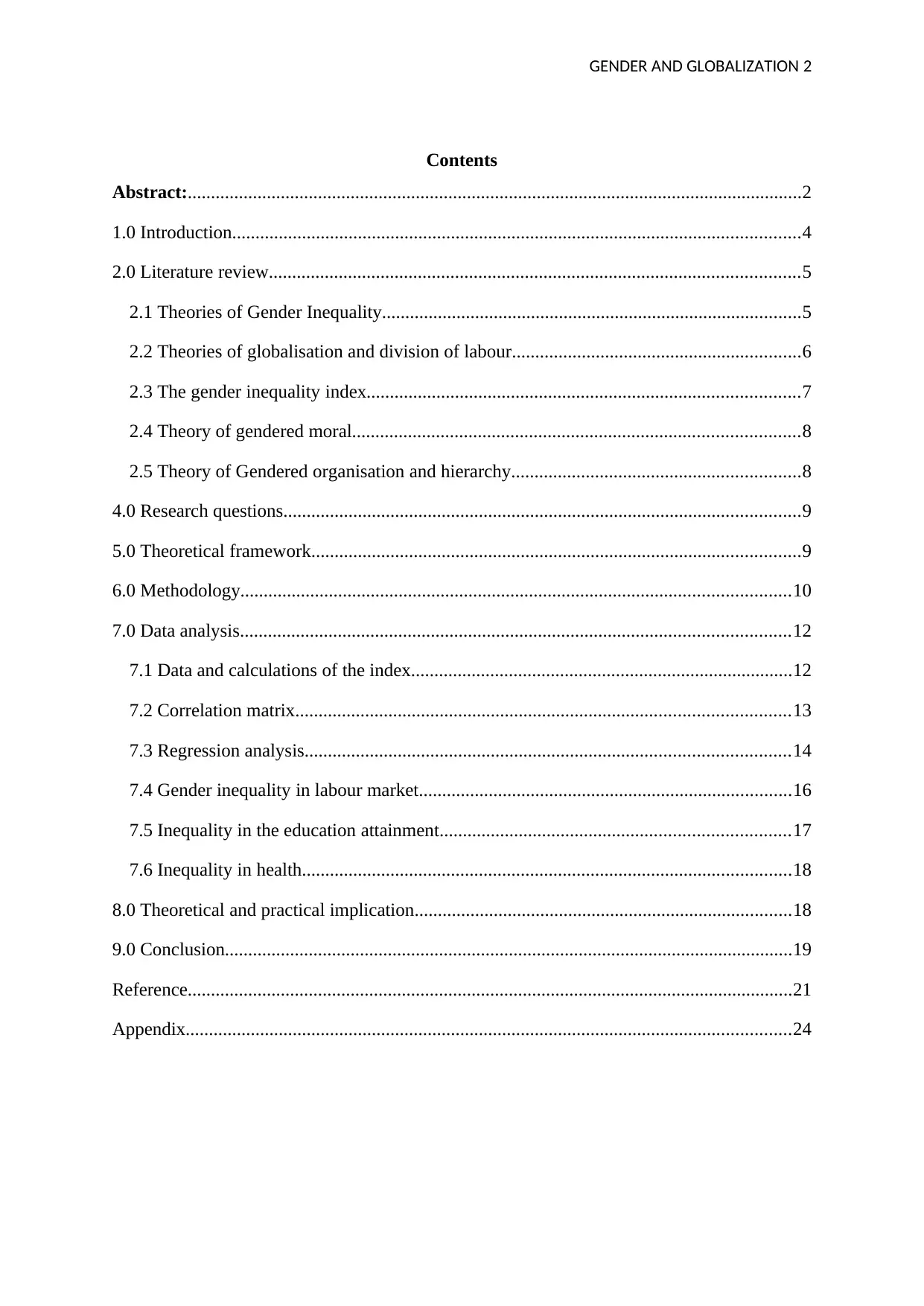
GENDER AND GLOBALIZATION 2
Contents
Abstract:....................................................................................................................................2
1.0 Introduction..........................................................................................................................4
2.0 Literature review..................................................................................................................5
2.1 Theories of Gender Inequality..........................................................................................5
2.2 Theories of globalisation and division of labour..............................................................6
2.3 The gender inequality index.............................................................................................7
2.4 Theory of gendered moral................................................................................................8
2.5 Theory of Gendered organisation and hierarchy..............................................................8
4.0 Research questions...............................................................................................................9
5.0 Theoretical framework.........................................................................................................9
6.0 Methodology......................................................................................................................10
7.0 Data analysis......................................................................................................................12
7.1 Data and calculations of the index..................................................................................12
7.2 Correlation matrix..........................................................................................................13
7.3 Regression analysis........................................................................................................14
7.4 Gender inequality in labour market................................................................................16
7.5 Inequality in the education attainment...........................................................................17
7.6 Inequality in health.........................................................................................................18
8.0 Theoretical and practical implication.................................................................................18
9.0 Conclusion..........................................................................................................................19
Reference..................................................................................................................................21
Appendix..................................................................................................................................24
Contents
Abstract:....................................................................................................................................2
1.0 Introduction..........................................................................................................................4
2.0 Literature review..................................................................................................................5
2.1 Theories of Gender Inequality..........................................................................................5
2.2 Theories of globalisation and division of labour..............................................................6
2.3 The gender inequality index.............................................................................................7
2.4 Theory of gendered moral................................................................................................8
2.5 Theory of Gendered organisation and hierarchy..............................................................8
4.0 Research questions...............................................................................................................9
5.0 Theoretical framework.........................................................................................................9
6.0 Methodology......................................................................................................................10
7.0 Data analysis......................................................................................................................12
7.1 Data and calculations of the index..................................................................................12
7.2 Correlation matrix..........................................................................................................13
7.3 Regression analysis........................................................................................................14
7.4 Gender inequality in labour market................................................................................16
7.5 Inequality in the education attainment...........................................................................17
7.6 Inequality in health.........................................................................................................18
8.0 Theoretical and practical implication.................................................................................18
9.0 Conclusion..........................................................................................................................19
Reference..................................................................................................................................21
Appendix..................................................................................................................................24
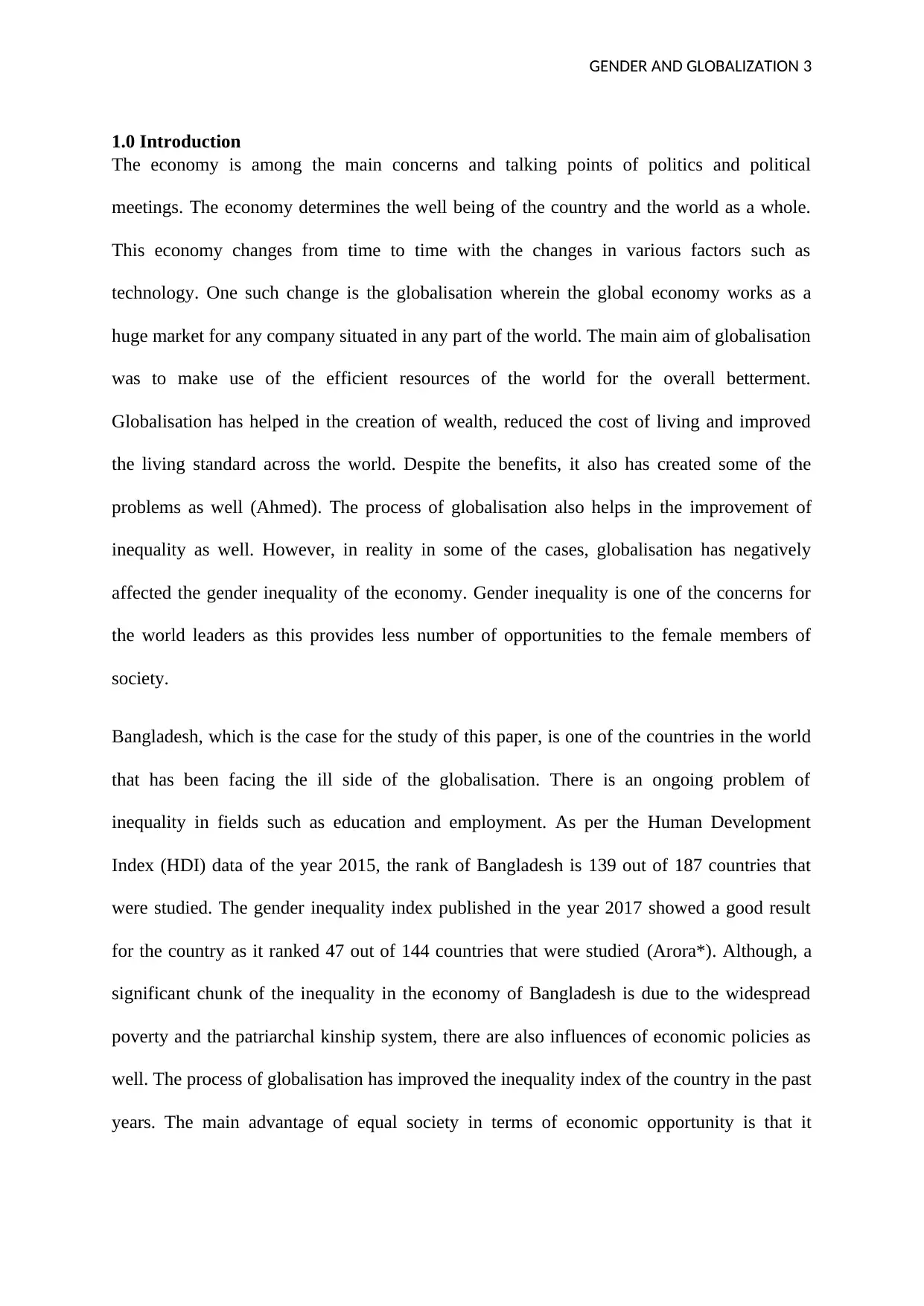
GENDER AND GLOBALIZATION 3
1.0 Introduction
The economy is among the main concerns and talking points of politics and political
meetings. The economy determines the well being of the country and the world as a whole.
This economy changes from time to time with the changes in various factors such as
technology. One such change is the globalisation wherein the global economy works as a
huge market for any company situated in any part of the world. The main aim of globalisation
was to make use of the efficient resources of the world for the overall betterment.
Globalisation has helped in the creation of wealth, reduced the cost of living and improved
the living standard across the world. Despite the benefits, it also has created some of the
problems as well (Ahmed). The process of globalisation also helps in the improvement of
inequality as well. However, in reality in some of the cases, globalisation has negatively
affected the gender inequality of the economy. Gender inequality is one of the concerns for
the world leaders as this provides less number of opportunities to the female members of
society.
Bangladesh, which is the case for the study of this paper, is one of the countries in the world
that has been facing the ill side of the globalisation. There is an ongoing problem of
inequality in fields such as education and employment. As per the Human Development
Index (HDI) data of the year 2015, the rank of Bangladesh is 139 out of 187 countries that
were studied. The gender inequality index published in the year 2017 showed a good result
for the country as it ranked 47 out of 144 countries that were studied (Arora*). Although, a
significant chunk of the inequality in the economy of Bangladesh is due to the widespread
poverty and the patriarchal kinship system, there are also influences of economic policies as
well. The process of globalisation has improved the inequality index of the country in the past
years. The main advantage of equal society in terms of economic opportunity is that it
1.0 Introduction
The economy is among the main concerns and talking points of politics and political
meetings. The economy determines the well being of the country and the world as a whole.
This economy changes from time to time with the changes in various factors such as
technology. One such change is the globalisation wherein the global economy works as a
huge market for any company situated in any part of the world. The main aim of globalisation
was to make use of the efficient resources of the world for the overall betterment.
Globalisation has helped in the creation of wealth, reduced the cost of living and improved
the living standard across the world. Despite the benefits, it also has created some of the
problems as well (Ahmed). The process of globalisation also helps in the improvement of
inequality as well. However, in reality in some of the cases, globalisation has negatively
affected the gender inequality of the economy. Gender inequality is one of the concerns for
the world leaders as this provides less number of opportunities to the female members of
society.
Bangladesh, which is the case for the study of this paper, is one of the countries in the world
that has been facing the ill side of the globalisation. There is an ongoing problem of
inequality in fields such as education and employment. As per the Human Development
Index (HDI) data of the year 2015, the rank of Bangladesh is 139 out of 187 countries that
were studied. The gender inequality index published in the year 2017 showed a good result
for the country as it ranked 47 out of 144 countries that were studied (Arora*). Although, a
significant chunk of the inequality in the economy of Bangladesh is due to the widespread
poverty and the patriarchal kinship system, there are also influences of economic policies as
well. The process of globalisation has improved the inequality index of the country in the past
years. The main advantage of equal society in terms of economic opportunity is that it
⊘ This is a preview!⊘
Do you want full access?
Subscribe today to unlock all pages.

Trusted by 1+ million students worldwide
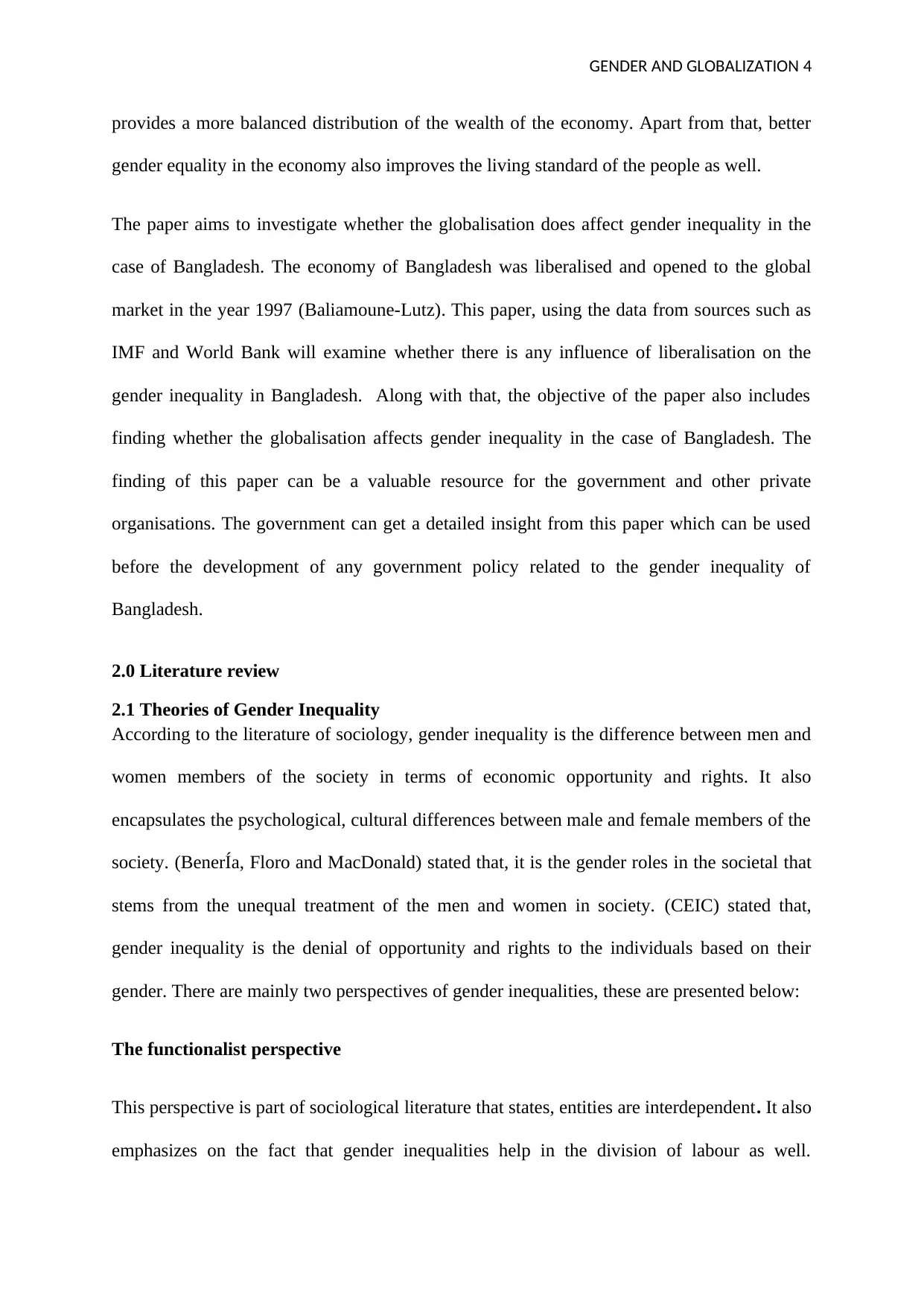
GENDER AND GLOBALIZATION 4
provides a more balanced distribution of the wealth of the economy. Apart from that, better
gender equality in the economy also improves the living standard of the people as well.
The paper aims to investigate whether the globalisation does affect gender inequality in the
case of Bangladesh. The economy of Bangladesh was liberalised and opened to the global
market in the year 1997 (Baliamoune-Lutz). This paper, using the data from sources such as
IMF and World Bank will examine whether there is any influence of liberalisation on the
gender inequality in Bangladesh. Along with that, the objective of the paper also includes
finding whether the globalisation affects gender inequality in the case of Bangladesh. The
finding of this paper can be a valuable resource for the government and other private
organisations. The government can get a detailed insight from this paper which can be used
before the development of any government policy related to the gender inequality of
Bangladesh.
2.0 Literature review
2.1 Theories of Gender Inequality
According to the literature of sociology, gender inequality is the difference between men and
women members of the society in terms of economic opportunity and rights. It also
encapsulates the psychological, cultural differences between male and female members of the
society. (BenerÍa, Floro and MacDonald) stated that, it is the gender roles in the societal that
stems from the unequal treatment of the men and women in society. (CEIC) stated that,
gender inequality is the denial of opportunity and rights to the individuals based on their
gender. There are mainly two perspectives of gender inequalities, these are presented below:
The functionalist perspective
This perspective is part of sociological literature that states, entities are interdependent. It also
emphasizes on the fact that gender inequalities help in the division of labour as well.
provides a more balanced distribution of the wealth of the economy. Apart from that, better
gender equality in the economy also improves the living standard of the people as well.
The paper aims to investigate whether the globalisation does affect gender inequality in the
case of Bangladesh. The economy of Bangladesh was liberalised and opened to the global
market in the year 1997 (Baliamoune-Lutz). This paper, using the data from sources such as
IMF and World Bank will examine whether there is any influence of liberalisation on the
gender inequality in Bangladesh. Along with that, the objective of the paper also includes
finding whether the globalisation affects gender inequality in the case of Bangladesh. The
finding of this paper can be a valuable resource for the government and other private
organisations. The government can get a detailed insight from this paper which can be used
before the development of any government policy related to the gender inequality of
Bangladesh.
2.0 Literature review
2.1 Theories of Gender Inequality
According to the literature of sociology, gender inequality is the difference between men and
women members of the society in terms of economic opportunity and rights. It also
encapsulates the psychological, cultural differences between male and female members of the
society. (BenerÍa, Floro and MacDonald) stated that, it is the gender roles in the societal that
stems from the unequal treatment of the men and women in society. (CEIC) stated that,
gender inequality is the denial of opportunity and rights to the individuals based on their
gender. There are mainly two perspectives of gender inequalities, these are presented below:
The functionalist perspective
This perspective is part of sociological literature that states, entities are interdependent. It also
emphasizes on the fact that gender inequalities help in the division of labour as well.
Paraphrase This Document
Need a fresh take? Get an instant paraphrase of this document with our AI Paraphraser
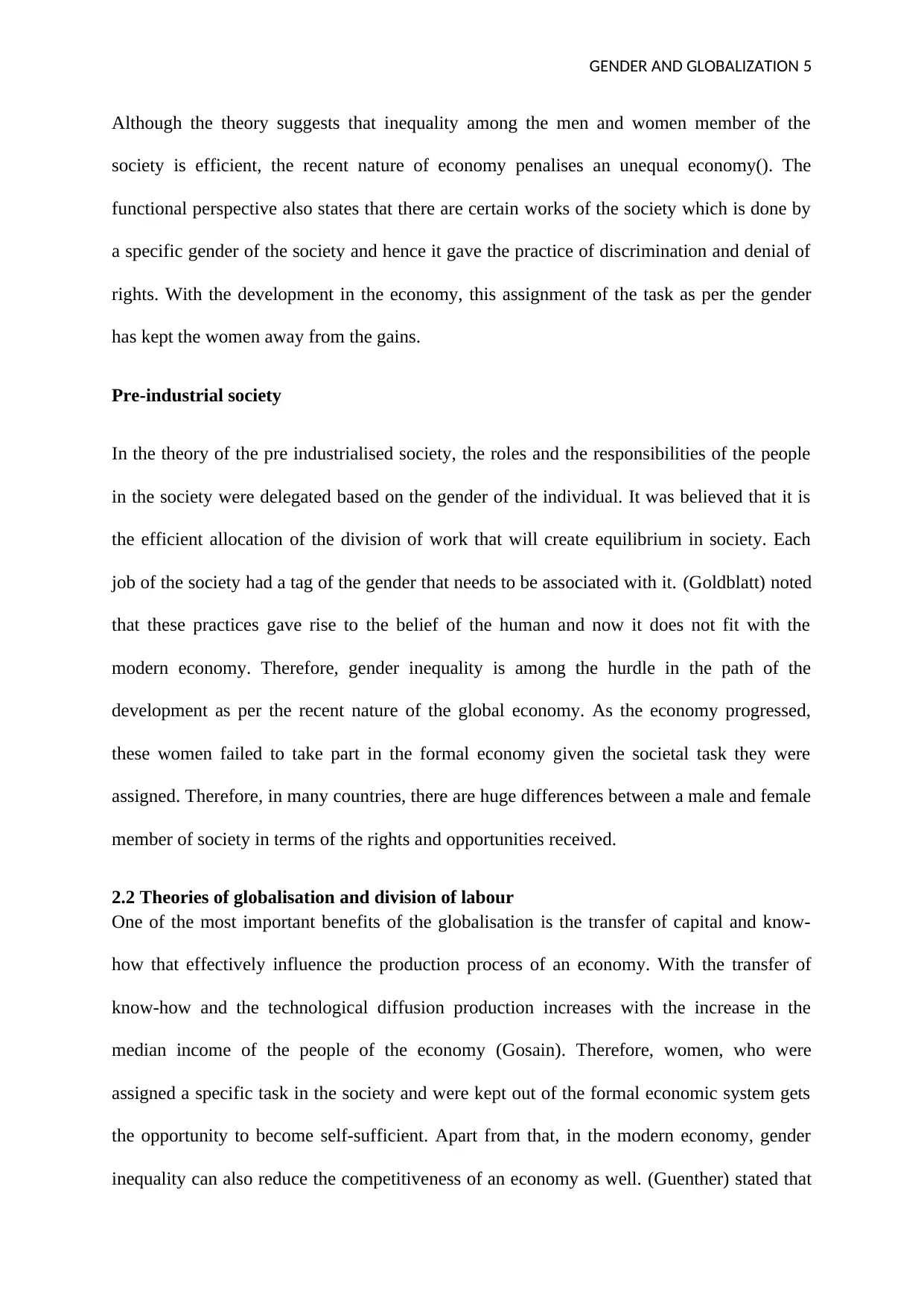
GENDER AND GLOBALIZATION 5
Although the theory suggests that inequality among the men and women member of the
society is efficient, the recent nature of economy penalises an unequal economy(). The
functional perspective also states that there are certain works of the society which is done by
a specific gender of the society and hence it gave the practice of discrimination and denial of
rights. With the development in the economy, this assignment of the task as per the gender
has kept the women away from the gains.
Pre-industrial society
In the theory of the pre industrialised society, the roles and the responsibilities of the people
in the society were delegated based on the gender of the individual. It was believed that it is
the efficient allocation of the division of work that will create equilibrium in society. Each
job of the society had a tag of the gender that needs to be associated with it. (Goldblatt) noted
that these practices gave rise to the belief of the human and now it does not fit with the
modern economy. Therefore, gender inequality is among the hurdle in the path of the
development as per the recent nature of the global economy. As the economy progressed,
these women failed to take part in the formal economy given the societal task they were
assigned. Therefore, in many countries, there are huge differences between a male and female
member of society in terms of the rights and opportunities received.
2.2 Theories of globalisation and division of labour
One of the most important benefits of the globalisation is the transfer of capital and know-
how that effectively influence the production process of an economy. With the transfer of
know-how and the technological diffusion production increases with the increase in the
median income of the people of the economy (Gosain). Therefore, women, who were
assigned a specific task in the society and were kept out of the formal economic system gets
the opportunity to become self-sufficient. Apart from that, in the modern economy, gender
inequality can also reduce the competitiveness of an economy as well. (Guenther) stated that
Although the theory suggests that inequality among the men and women member of the
society is efficient, the recent nature of economy penalises an unequal economy(). The
functional perspective also states that there are certain works of the society which is done by
a specific gender of the society and hence it gave the practice of discrimination and denial of
rights. With the development in the economy, this assignment of the task as per the gender
has kept the women away from the gains.
Pre-industrial society
In the theory of the pre industrialised society, the roles and the responsibilities of the people
in the society were delegated based on the gender of the individual. It was believed that it is
the efficient allocation of the division of work that will create equilibrium in society. Each
job of the society had a tag of the gender that needs to be associated with it. (Goldblatt) noted
that these practices gave rise to the belief of the human and now it does not fit with the
modern economy. Therefore, gender inequality is among the hurdle in the path of the
development as per the recent nature of the global economy. As the economy progressed,
these women failed to take part in the formal economy given the societal task they were
assigned. Therefore, in many countries, there are huge differences between a male and female
member of society in terms of the rights and opportunities received.
2.2 Theories of globalisation and division of labour
One of the most important benefits of the globalisation is the transfer of capital and know-
how that effectively influence the production process of an economy. With the transfer of
know-how and the technological diffusion production increases with the increase in the
median income of the people of the economy (Gosain). Therefore, women, who were
assigned a specific task in the society and were kept out of the formal economic system gets
the opportunity to become self-sufficient. Apart from that, in the modern economy, gender
inequality can also reduce the competitiveness of an economy as well. (Guenther) stated that
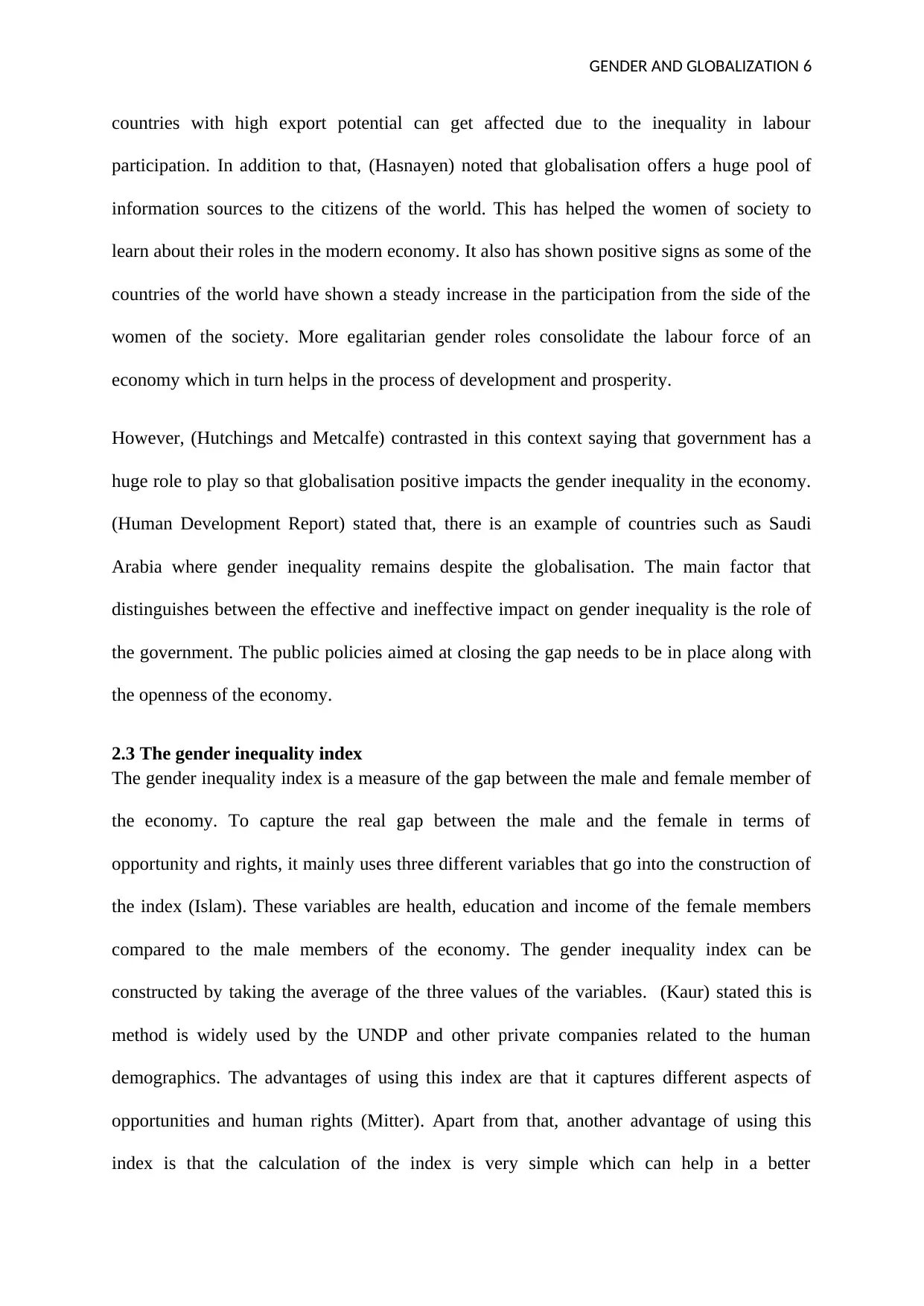
GENDER AND GLOBALIZATION 6
countries with high export potential can get affected due to the inequality in labour
participation. In addition to that, (Hasnayen) noted that globalisation offers a huge pool of
information sources to the citizens of the world. This has helped the women of society to
learn about their roles in the modern economy. It also has shown positive signs as some of the
countries of the world have shown a steady increase in the participation from the side of the
women of the society. More egalitarian gender roles consolidate the labour force of an
economy which in turn helps in the process of development and prosperity.
However, (Hutchings and Metcalfe) contrasted in this context saying that government has a
huge role to play so that globalisation positive impacts the gender inequality in the economy.
(Human Development Report) stated that, there is an example of countries such as Saudi
Arabia where gender inequality remains despite the globalisation. The main factor that
distinguishes between the effective and ineffective impact on gender inequality is the role of
the government. The public policies aimed at closing the gap needs to be in place along with
the openness of the economy.
2.3 The gender inequality index
The gender inequality index is a measure of the gap between the male and female member of
the economy. To capture the real gap between the male and the female in terms of
opportunity and rights, it mainly uses three different variables that go into the construction of
the index (Islam). These variables are health, education and income of the female members
compared to the male members of the economy. The gender inequality index can be
constructed by taking the average of the three values of the variables. (Kaur) stated this is
method is widely used by the UNDP and other private companies related to the human
demographics. The advantages of using this index are that it captures different aspects of
opportunities and human rights (Mitter). Apart from that, another advantage of using this
index is that the calculation of the index is very simple which can help in a better
countries with high export potential can get affected due to the inequality in labour
participation. In addition to that, (Hasnayen) noted that globalisation offers a huge pool of
information sources to the citizens of the world. This has helped the women of society to
learn about their roles in the modern economy. It also has shown positive signs as some of the
countries of the world have shown a steady increase in the participation from the side of the
women of the society. More egalitarian gender roles consolidate the labour force of an
economy which in turn helps in the process of development and prosperity.
However, (Hutchings and Metcalfe) contrasted in this context saying that government has a
huge role to play so that globalisation positive impacts the gender inequality in the economy.
(Human Development Report) stated that, there is an example of countries such as Saudi
Arabia where gender inequality remains despite the globalisation. The main factor that
distinguishes between the effective and ineffective impact on gender inequality is the role of
the government. The public policies aimed at closing the gap needs to be in place along with
the openness of the economy.
2.3 The gender inequality index
The gender inequality index is a measure of the gap between the male and female member of
the economy. To capture the real gap between the male and the female in terms of
opportunity and rights, it mainly uses three different variables that go into the construction of
the index (Islam). These variables are health, education and income of the female members
compared to the male members of the economy. The gender inequality index can be
constructed by taking the average of the three values of the variables. (Kaur) stated this is
method is widely used by the UNDP and other private companies related to the human
demographics. The advantages of using this index are that it captures different aspects of
opportunities and human rights (Mitter). Apart from that, another advantage of using this
index is that the calculation of the index is very simple which can help in a better
⊘ This is a preview!⊘
Do you want full access?
Subscribe today to unlock all pages.

Trusted by 1+ million students worldwide
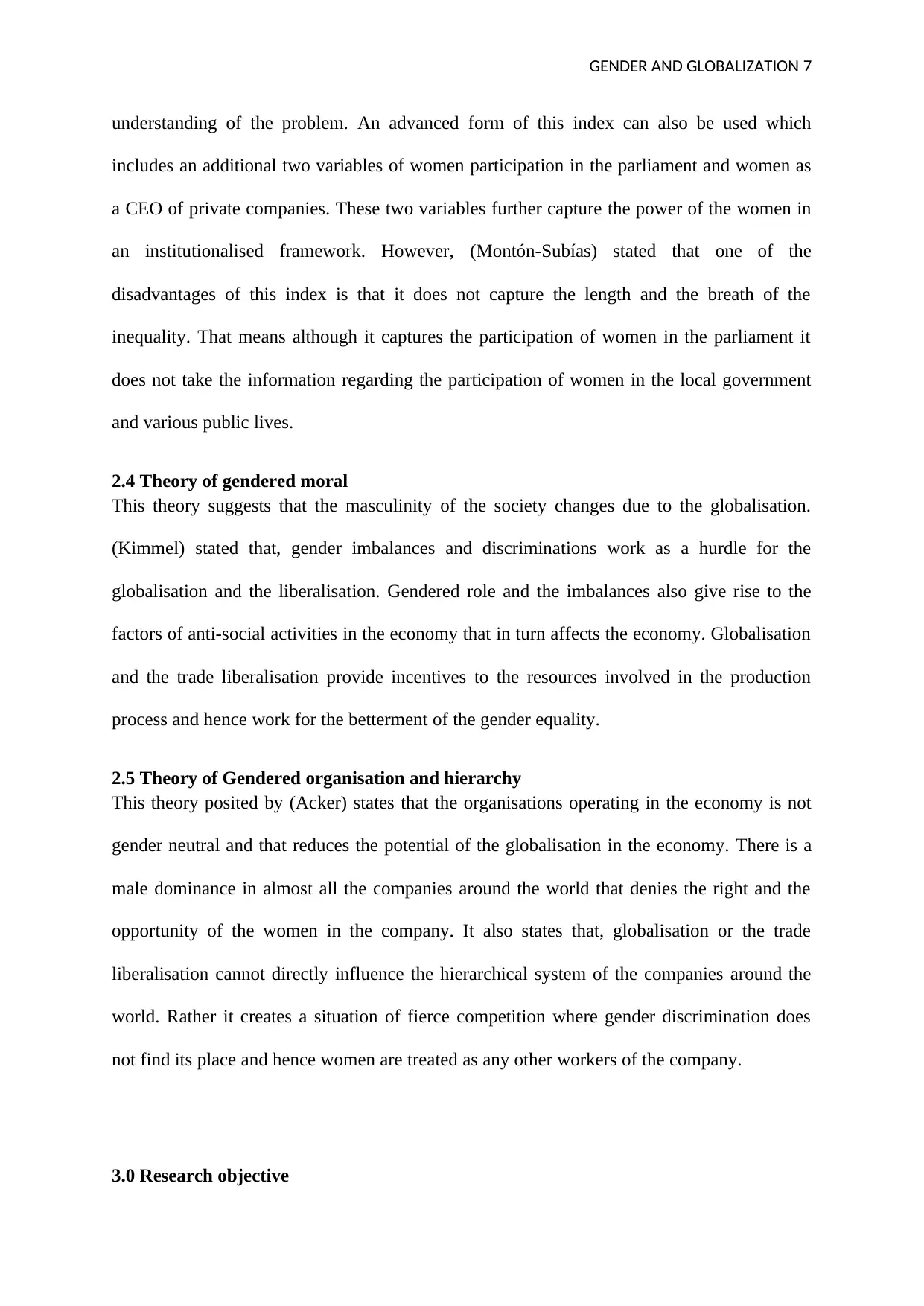
GENDER AND GLOBALIZATION 7
understanding of the problem. An advanced form of this index can also be used which
includes an additional two variables of women participation in the parliament and women as
a CEO of private companies. These two variables further capture the power of the women in
an institutionalised framework. However, (Montón-Subías) stated that one of the
disadvantages of this index is that it does not capture the length and the breath of the
inequality. That means although it captures the participation of women in the parliament it
does not take the information regarding the participation of women in the local government
and various public lives.
2.4 Theory of gendered moral
This theory suggests that the masculinity of the society changes due to the globalisation.
(Kimmel) stated that, gender imbalances and discriminations work as a hurdle for the
globalisation and the liberalisation. Gendered role and the imbalances also give rise to the
factors of anti-social activities in the economy that in turn affects the economy. Globalisation
and the trade liberalisation provide incentives to the resources involved in the production
process and hence work for the betterment of the gender equality.
2.5 Theory of Gendered organisation and hierarchy
This theory posited by (Acker) states that the organisations operating in the economy is not
gender neutral and that reduces the potential of the globalisation in the economy. There is a
male dominance in almost all the companies around the world that denies the right and the
opportunity of the women in the company. It also states that, globalisation or the trade
liberalisation cannot directly influence the hierarchical system of the companies around the
world. Rather it creates a situation of fierce competition where gender discrimination does
not find its place and hence women are treated as any other workers of the company.
3.0 Research objective
understanding of the problem. An advanced form of this index can also be used which
includes an additional two variables of women participation in the parliament and women as
a CEO of private companies. These two variables further capture the power of the women in
an institutionalised framework. However, (Montón-Subías) stated that one of the
disadvantages of this index is that it does not capture the length and the breath of the
inequality. That means although it captures the participation of women in the parliament it
does not take the information regarding the participation of women in the local government
and various public lives.
2.4 Theory of gendered moral
This theory suggests that the masculinity of the society changes due to the globalisation.
(Kimmel) stated that, gender imbalances and discriminations work as a hurdle for the
globalisation and the liberalisation. Gendered role and the imbalances also give rise to the
factors of anti-social activities in the economy that in turn affects the economy. Globalisation
and the trade liberalisation provide incentives to the resources involved in the production
process and hence work for the betterment of the gender equality.
2.5 Theory of Gendered organisation and hierarchy
This theory posited by (Acker) states that the organisations operating in the economy is not
gender neutral and that reduces the potential of the globalisation in the economy. There is a
male dominance in almost all the companies around the world that denies the right and the
opportunity of the women in the company. It also states that, globalisation or the trade
liberalisation cannot directly influence the hierarchical system of the companies around the
world. Rather it creates a situation of fierce competition where gender discrimination does
not find its place and hence women are treated as any other workers of the company.
3.0 Research objective
Paraphrase This Document
Need a fresh take? Get an instant paraphrase of this document with our AI Paraphraser
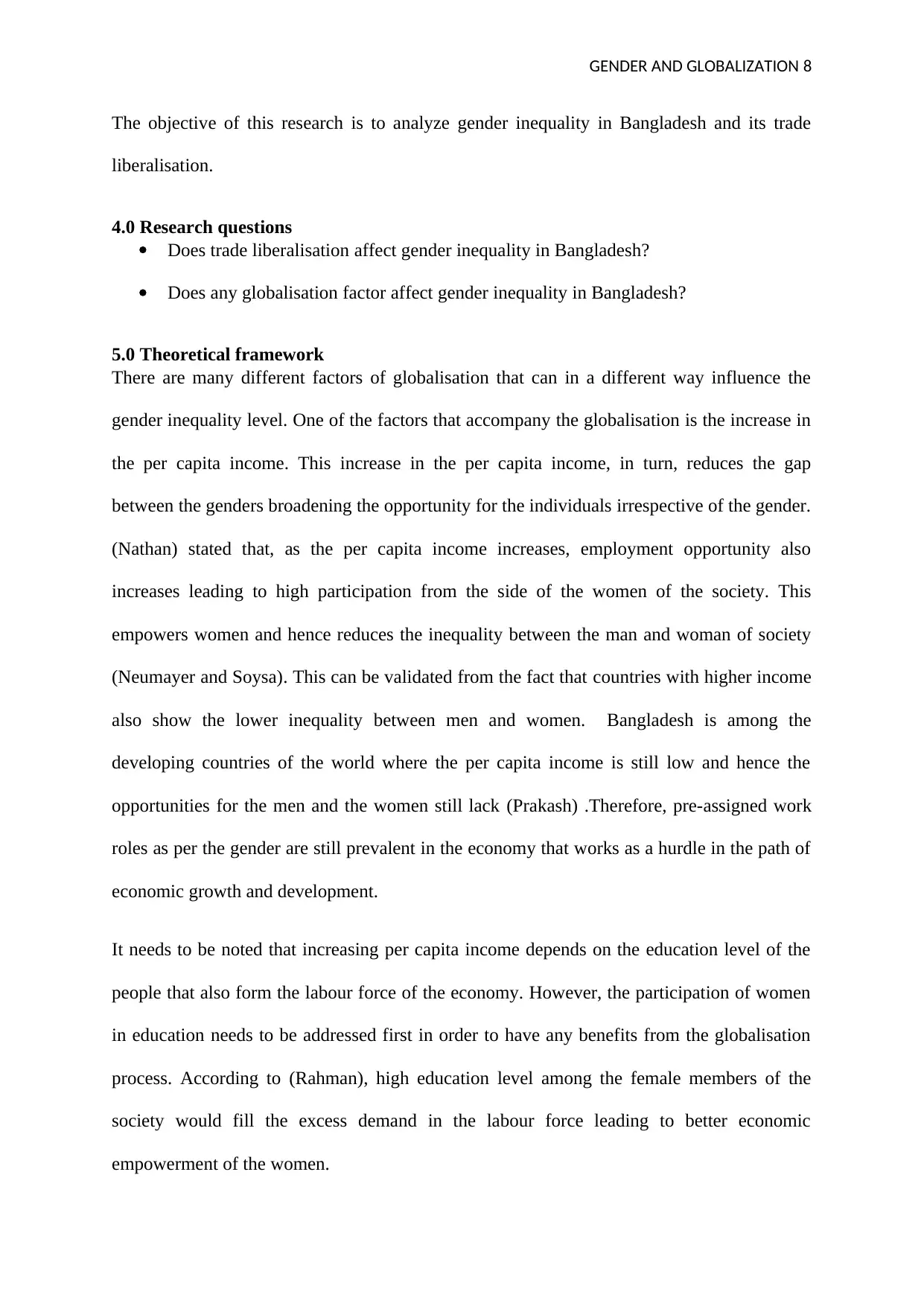
GENDER AND GLOBALIZATION 8
The objective of this research is to analyze gender inequality in Bangladesh and its trade
liberalisation.
4.0 Research questions
Does trade liberalisation affect gender inequality in Bangladesh?
Does any globalisation factor affect gender inequality in Bangladesh?
5.0 Theoretical framework
There are many different factors of globalisation that can in a different way influence the
gender inequality level. One of the factors that accompany the globalisation is the increase in
the per capita income. This increase in the per capita income, in turn, reduces the gap
between the genders broadening the opportunity for the individuals irrespective of the gender.
(Nathan) stated that, as the per capita income increases, employment opportunity also
increases leading to high participation from the side of the women of the society. This
empowers women and hence reduces the inequality between the man and woman of society
(Neumayer and Soysa). This can be validated from the fact that countries with higher income
also show the lower inequality between men and women. Bangladesh is among the
developing countries of the world where the per capita income is still low and hence the
opportunities for the men and the women still lack (Prakash) .Therefore, pre-assigned work
roles as per the gender are still prevalent in the economy that works as a hurdle in the path of
economic growth and development.
It needs to be noted that increasing per capita income depends on the education level of the
people that also form the labour force of the economy. However, the participation of women
in education needs to be addressed first in order to have any benefits from the globalisation
process. According to (Rahman), high education level among the female members of the
society would fill the excess demand in the labour force leading to better economic
empowerment of the women.
The objective of this research is to analyze gender inequality in Bangladesh and its trade
liberalisation.
4.0 Research questions
Does trade liberalisation affect gender inequality in Bangladesh?
Does any globalisation factor affect gender inequality in Bangladesh?
5.0 Theoretical framework
There are many different factors of globalisation that can in a different way influence the
gender inequality level. One of the factors that accompany the globalisation is the increase in
the per capita income. This increase in the per capita income, in turn, reduces the gap
between the genders broadening the opportunity for the individuals irrespective of the gender.
(Nathan) stated that, as the per capita income increases, employment opportunity also
increases leading to high participation from the side of the women of the society. This
empowers women and hence reduces the inequality between the man and woman of society
(Neumayer and Soysa). This can be validated from the fact that countries with higher income
also show the lower inequality between men and women. Bangladesh is among the
developing countries of the world where the per capita income is still low and hence the
opportunities for the men and the women still lack (Prakash) .Therefore, pre-assigned work
roles as per the gender are still prevalent in the economy that works as a hurdle in the path of
economic growth and development.
It needs to be noted that increasing per capita income depends on the education level of the
people that also form the labour force of the economy. However, the participation of women
in education needs to be addressed first in order to have any benefits from the globalisation
process. According to (Rahman), high education level among the female members of the
society would fill the excess demand in the labour force leading to better economic
empowerment of the women.
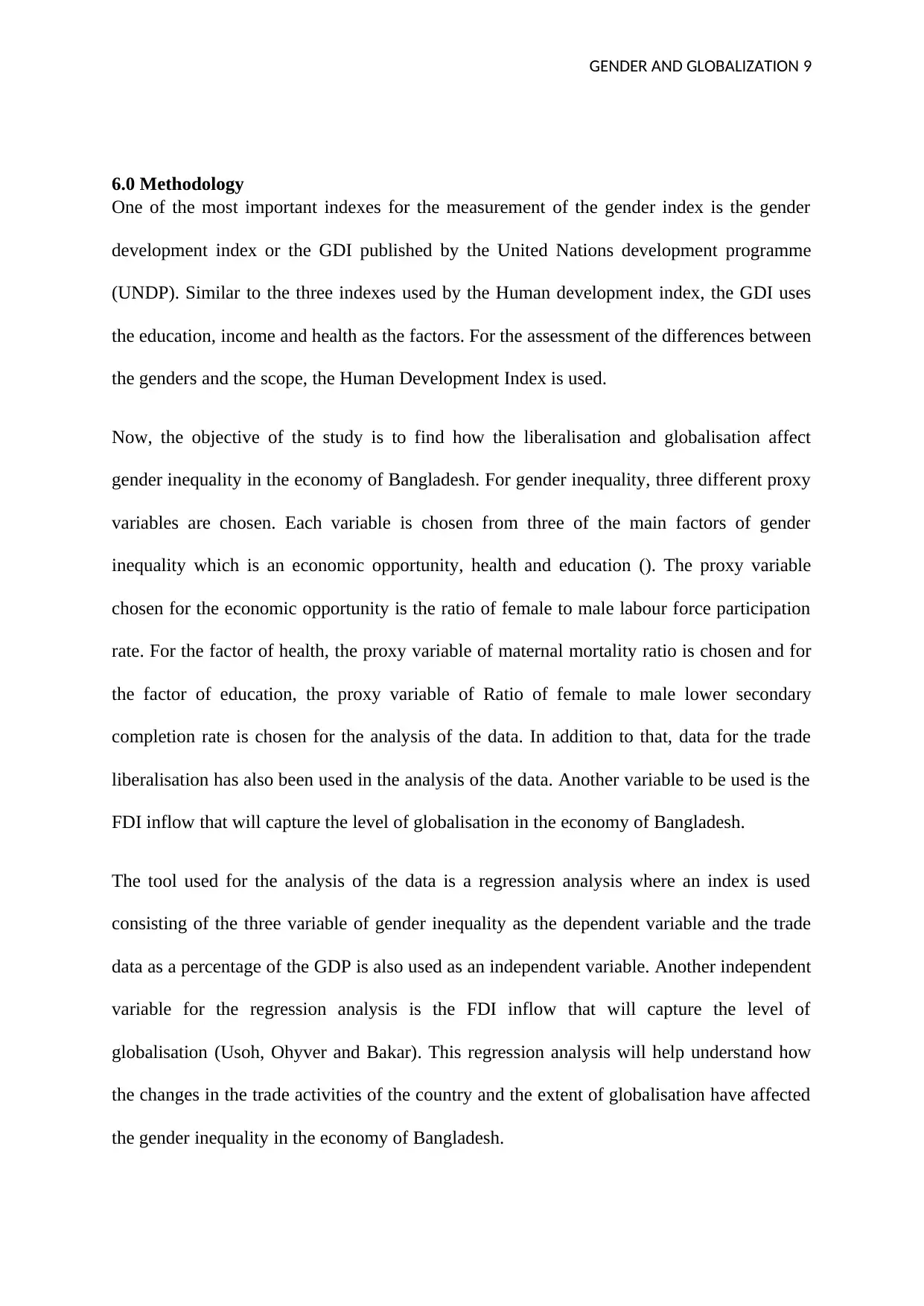
GENDER AND GLOBALIZATION 9
6.0 Methodology
One of the most important indexes for the measurement of the gender index is the gender
development index or the GDI published by the United Nations development programme
(UNDP). Similar to the three indexes used by the Human development index, the GDI uses
the education, income and health as the factors. For the assessment of the differences between
the genders and the scope, the Human Development Index is used.
Now, the objective of the study is to find how the liberalisation and globalisation affect
gender inequality in the economy of Bangladesh. For gender inequality, three different proxy
variables are chosen. Each variable is chosen from three of the main factors of gender
inequality which is an economic opportunity, health and education (). The proxy variable
chosen for the economic opportunity is the ratio of female to male labour force participation
rate. For the factor of health, the proxy variable of maternal mortality ratio is chosen and for
the factor of education, the proxy variable of Ratio of female to male lower secondary
completion rate is chosen for the analysis of the data. In addition to that, data for the trade
liberalisation has also been used in the analysis of the data. Another variable to be used is the
FDI inflow that will capture the level of globalisation in the economy of Bangladesh.
The tool used for the analysis of the data is a regression analysis where an index is used
consisting of the three variable of gender inequality as the dependent variable and the trade
data as a percentage of the GDP is also used as an independent variable. Another independent
variable for the regression analysis is the FDI inflow that will capture the level of
globalisation (Usoh, Ohyver and Bakar). This regression analysis will help understand how
the changes in the trade activities of the country and the extent of globalisation have affected
the gender inequality in the economy of Bangladesh.
6.0 Methodology
One of the most important indexes for the measurement of the gender index is the gender
development index or the GDI published by the United Nations development programme
(UNDP). Similar to the three indexes used by the Human development index, the GDI uses
the education, income and health as the factors. For the assessment of the differences between
the genders and the scope, the Human Development Index is used.
Now, the objective of the study is to find how the liberalisation and globalisation affect
gender inequality in the economy of Bangladesh. For gender inequality, three different proxy
variables are chosen. Each variable is chosen from three of the main factors of gender
inequality which is an economic opportunity, health and education (). The proxy variable
chosen for the economic opportunity is the ratio of female to male labour force participation
rate. For the factor of health, the proxy variable of maternal mortality ratio is chosen and for
the factor of education, the proxy variable of Ratio of female to male lower secondary
completion rate is chosen for the analysis of the data. In addition to that, data for the trade
liberalisation has also been used in the analysis of the data. Another variable to be used is the
FDI inflow that will capture the level of globalisation in the economy of Bangladesh.
The tool used for the analysis of the data is a regression analysis where an index is used
consisting of the three variable of gender inequality as the dependent variable and the trade
data as a percentage of the GDP is also used as an independent variable. Another independent
variable for the regression analysis is the FDI inflow that will capture the level of
globalisation (Usoh, Ohyver and Bakar). This regression analysis will help understand how
the changes in the trade activities of the country and the extent of globalisation have affected
the gender inequality in the economy of Bangladesh.
⊘ This is a preview!⊘
Do you want full access?
Subscribe today to unlock all pages.

Trusted by 1+ million students worldwide
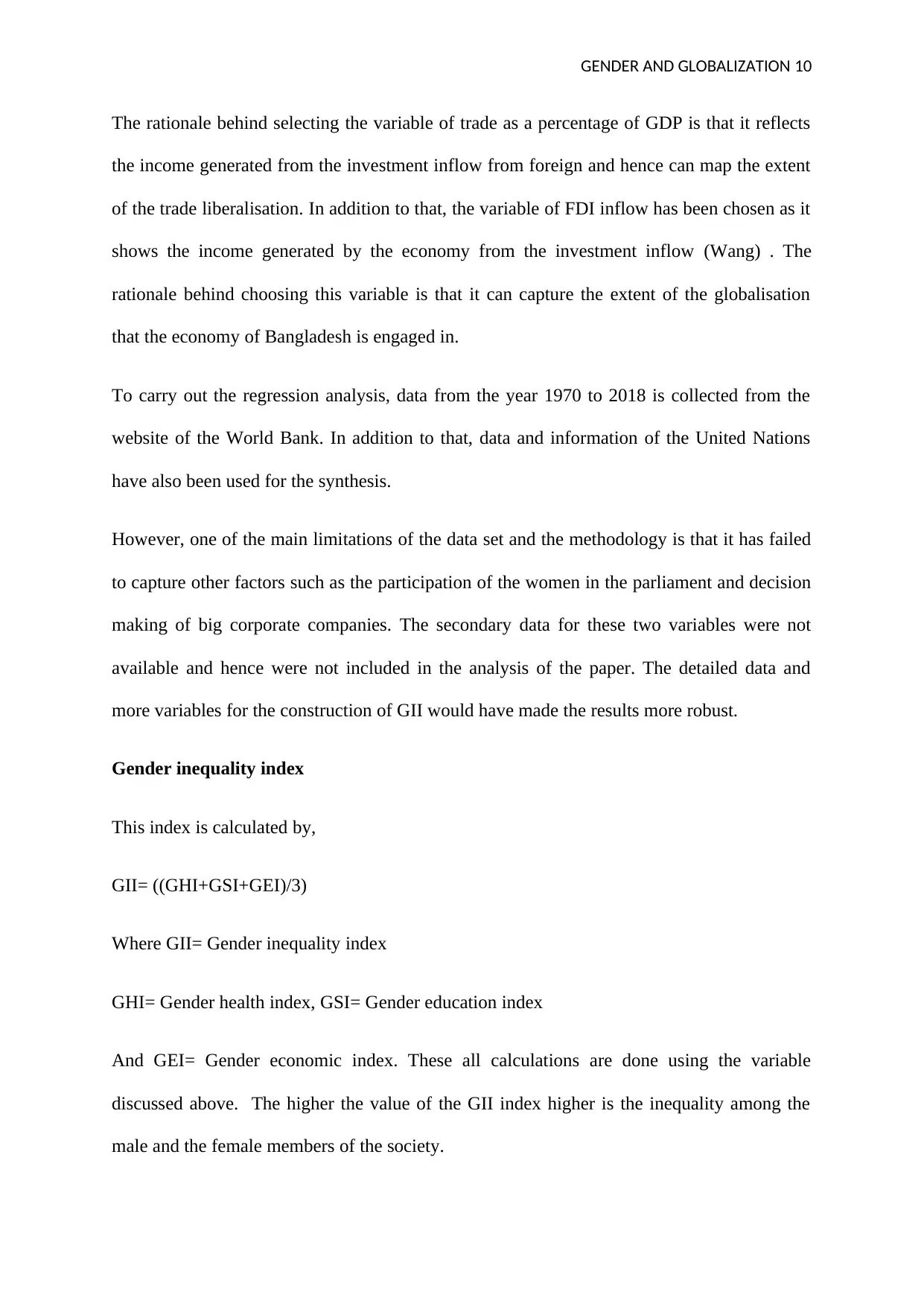
GENDER AND GLOBALIZATION 10
The rationale behind selecting the variable of trade as a percentage of GDP is that it reflects
the income generated from the investment inflow from foreign and hence can map the extent
of the trade liberalisation. In addition to that, the variable of FDI inflow has been chosen as it
shows the income generated by the economy from the investment inflow (Wang) . The
rationale behind choosing this variable is that it can capture the extent of the globalisation
that the economy of Bangladesh is engaged in.
To carry out the regression analysis, data from the year 1970 to 2018 is collected from the
website of the World Bank. In addition to that, data and information of the United Nations
have also been used for the synthesis.
However, one of the main limitations of the data set and the methodology is that it has failed
to capture other factors such as the participation of the women in the parliament and decision
making of big corporate companies. The secondary data for these two variables were not
available and hence were not included in the analysis of the paper. The detailed data and
more variables for the construction of GII would have made the results more robust.
Gender inequality index
This index is calculated by,
GII= ((GHI+GSI+GEI)/3)
Where GII= Gender inequality index
GHI= Gender health index, GSI= Gender education index
And GEI= Gender economic index. These all calculations are done using the variable
discussed above. The higher the value of the GII index higher is the inequality among the
male and the female members of the society.
The rationale behind selecting the variable of trade as a percentage of GDP is that it reflects
the income generated from the investment inflow from foreign and hence can map the extent
of the trade liberalisation. In addition to that, the variable of FDI inflow has been chosen as it
shows the income generated by the economy from the investment inflow (Wang) . The
rationale behind choosing this variable is that it can capture the extent of the globalisation
that the economy of Bangladesh is engaged in.
To carry out the regression analysis, data from the year 1970 to 2018 is collected from the
website of the World Bank. In addition to that, data and information of the United Nations
have also been used for the synthesis.
However, one of the main limitations of the data set and the methodology is that it has failed
to capture other factors such as the participation of the women in the parliament and decision
making of big corporate companies. The secondary data for these two variables were not
available and hence were not included in the analysis of the paper. The detailed data and
more variables for the construction of GII would have made the results more robust.
Gender inequality index
This index is calculated by,
GII= ((GHI+GSI+GEI)/3)
Where GII= Gender inequality index
GHI= Gender health index, GSI= Gender education index
And GEI= Gender economic index. These all calculations are done using the variable
discussed above. The higher the value of the GII index higher is the inequality among the
male and the female members of the society.
Paraphrase This Document
Need a fresh take? Get an instant paraphrase of this document with our AI Paraphraser
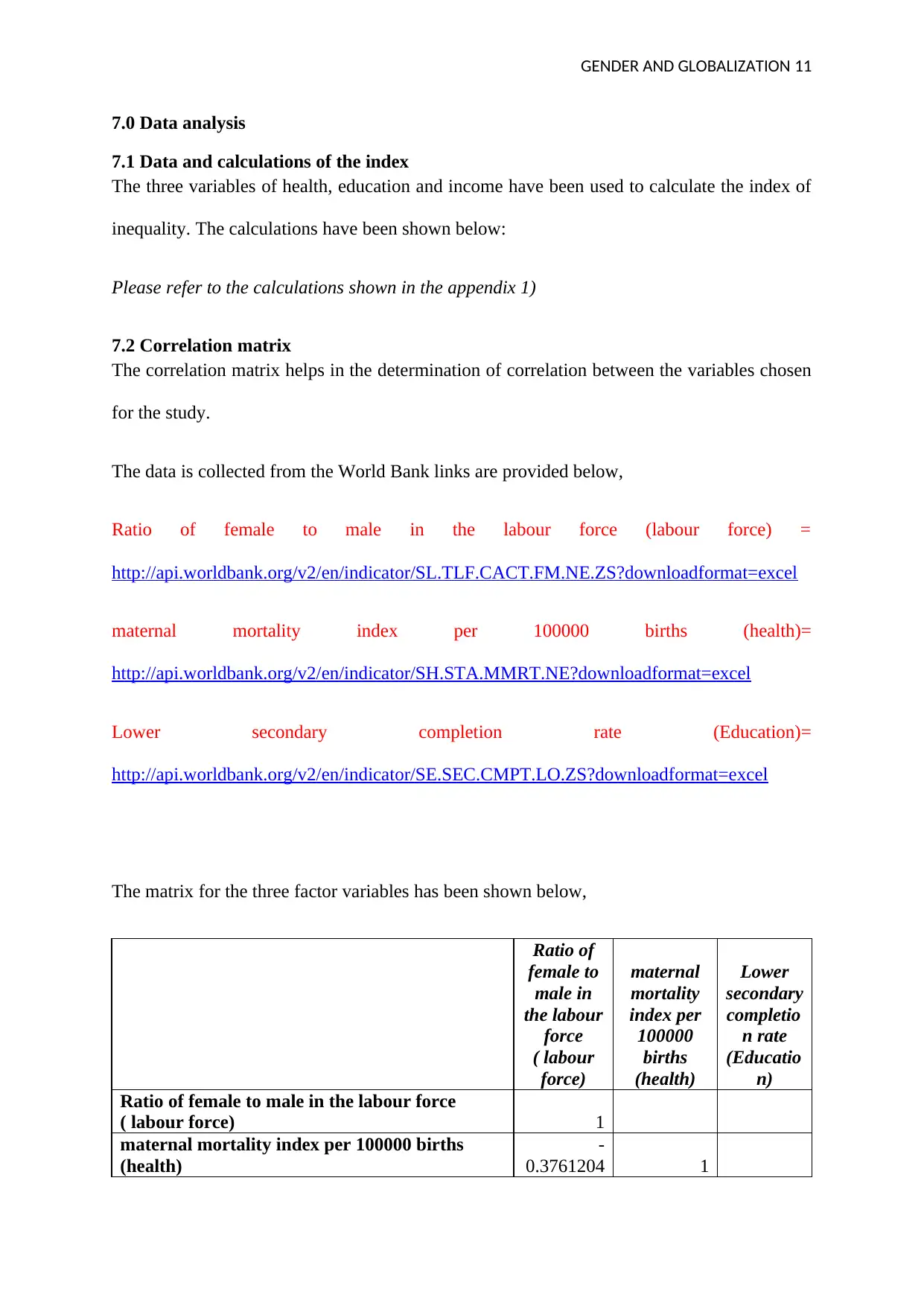
GENDER AND GLOBALIZATION 11
7.0 Data analysis
7.1 Data and calculations of the index
The three variables of health, education and income have been used to calculate the index of
inequality. The calculations have been shown below:
Please refer to the calculations shown in the appendix 1)
7.2 Correlation matrix
The correlation matrix helps in the determination of correlation between the variables chosen
for the study.
The data is collected from the World Bank links are provided below,
Ratio of female to male in the labour force (labour force) =
http://api.worldbank.org/v2/en/indicator/SL.TLF.CACT.FM.NE.ZS?downloadformat=excel
maternal mortality index per 100000 births (health)=
http://api.worldbank.org/v2/en/indicator/SH.STA.MMRT.NE?downloadformat=excel
Lower secondary completion rate (Education)=
http://api.worldbank.org/v2/en/indicator/SE.SEC.CMPT.LO.ZS?downloadformat=excel
The matrix for the three factor variables has been shown below,
Ratio of
female to
male in
the labour
force
( labour
force)
maternal
mortality
index per
100000
births
(health)
Lower
secondary
completio
n rate
(Educatio
n)
Ratio of female to male in the labour force
( labour force) 1
maternal mortality index per 100000 births
(health)
-
0.3761204 1
7.0 Data analysis
7.1 Data and calculations of the index
The three variables of health, education and income have been used to calculate the index of
inequality. The calculations have been shown below:
Please refer to the calculations shown in the appendix 1)
7.2 Correlation matrix
The correlation matrix helps in the determination of correlation between the variables chosen
for the study.
The data is collected from the World Bank links are provided below,
Ratio of female to male in the labour force (labour force) =
http://api.worldbank.org/v2/en/indicator/SL.TLF.CACT.FM.NE.ZS?downloadformat=excel
maternal mortality index per 100000 births (health)=
http://api.worldbank.org/v2/en/indicator/SH.STA.MMRT.NE?downloadformat=excel
Lower secondary completion rate (Education)=
http://api.worldbank.org/v2/en/indicator/SE.SEC.CMPT.LO.ZS?downloadformat=excel
The matrix for the three factor variables has been shown below,
Ratio of
female to
male in
the labour
force
( labour
force)
maternal
mortality
index per
100000
births
(health)
Lower
secondary
completio
n rate
(Educatio
n)
Ratio of female to male in the labour force
( labour force) 1
maternal mortality index per 100000 births
(health)
-
0.3761204 1
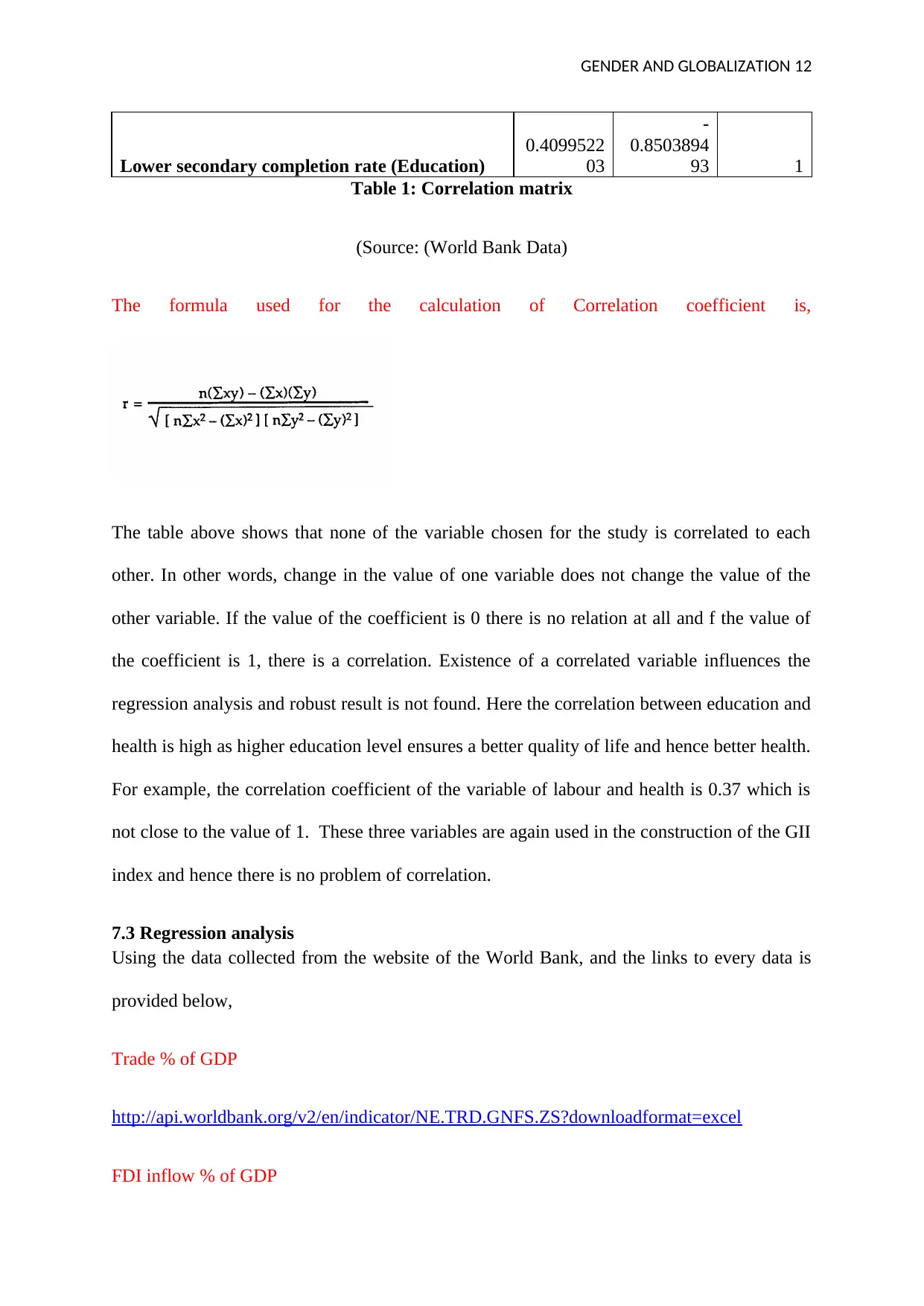
GENDER AND GLOBALIZATION 12
Lower secondary completion rate (Education)
0.4099522
03
-
0.8503894
93 1
Table 1: Correlation matrix
(Source: (World Bank Data)
The formula used for the calculation of Correlation coefficient is,
The table above shows that none of the variable chosen for the study is correlated to each
other. In other words, change in the value of one variable does not change the value of the
other variable. If the value of the coefficient is 0 there is no relation at all and f the value of
the coefficient is 1, there is a correlation. Existence of a correlated variable influences the
regression analysis and robust result is not found. Here the correlation between education and
health is high as higher education level ensures a better quality of life and hence better health.
For example, the correlation coefficient of the variable of labour and health is 0.37 which is
not close to the value of 1. These three variables are again used in the construction of the GII
index and hence there is no problem of correlation.
7.3 Regression analysis
Using the data collected from the website of the World Bank, and the links to every data is
provided below,
Trade % of GDP
http://api.worldbank.org/v2/en/indicator/NE.TRD.GNFS.ZS?downloadformat=excel
FDI inflow % of GDP
Lower secondary completion rate (Education)
0.4099522
03
-
0.8503894
93 1
Table 1: Correlation matrix
(Source: (World Bank Data)
The formula used for the calculation of Correlation coefficient is,
The table above shows that none of the variable chosen for the study is correlated to each
other. In other words, change in the value of one variable does not change the value of the
other variable. If the value of the coefficient is 0 there is no relation at all and f the value of
the coefficient is 1, there is a correlation. Existence of a correlated variable influences the
regression analysis and robust result is not found. Here the correlation between education and
health is high as higher education level ensures a better quality of life and hence better health.
For example, the correlation coefficient of the variable of labour and health is 0.37 which is
not close to the value of 1. These three variables are again used in the construction of the GII
index and hence there is no problem of correlation.
7.3 Regression analysis
Using the data collected from the website of the World Bank, and the links to every data is
provided below,
Trade % of GDP
http://api.worldbank.org/v2/en/indicator/NE.TRD.GNFS.ZS?downloadformat=excel
FDI inflow % of GDP
⊘ This is a preview!⊘
Do you want full access?
Subscribe today to unlock all pages.

Trusted by 1+ million students worldwide
1 out of 29
Your All-in-One AI-Powered Toolkit for Academic Success.
+13062052269
info@desklib.com
Available 24*7 on WhatsApp / Email
![[object Object]](/_next/static/media/star-bottom.7253800d.svg)
Unlock your academic potential
Copyright © 2020–2025 A2Z Services. All Rights Reserved. Developed and managed by ZUCOL.